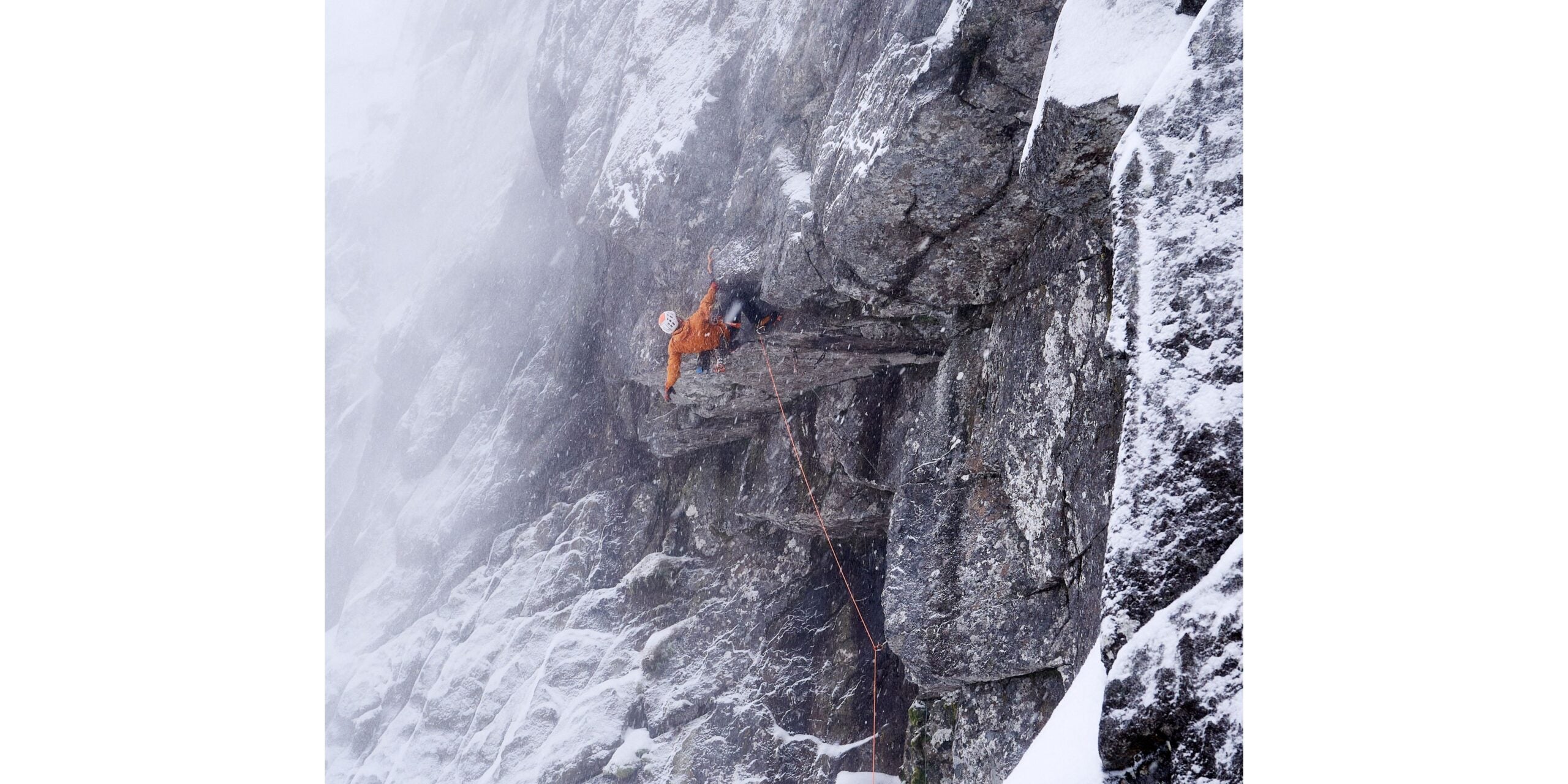Why You Should Care About Scotland’s Hardest Winter Route

Greg Boswell fires the crux first pitch of 'Bring Da Ruckus' (XII,13/M12). Note: While Boswell looks horribly runout on the orange rope, a second grey half rope is clipped to protection beneath the roof. (Photo: Courtesy Hamish Frost)
Last month, Greg Boswell established Bring Da Ruckus (XII, 13) at Lochnagar, Scotland. The 200-foot line is the most technically difficult winter route in a country renowned for its heinous winter climbing.
Amazingly, Boswell’s success on the route didn’t come after many weeks of trying. In fact, when he hiked to the crag with his partners Hamish Frost and Jamie Skelton, they didn’t even have a particular route in mind—just a wish to be out of avalanche terrain while a thick snow squall raged around them. The trio reached the foot of the Shadow Buttress and Boswell admitted that the roof was already on his radar. “The area has been a bit of a mythical part of the mountain for years,” Boswell told me. “Everyone knew about the steep roofs and hard-looking projects, but most people thought it was too futuristic for the Scottish ground-up ethic.”
This “ground-up ethic” is what makes climbing in Scotland special, Boswell noted. Local custom dictates that winter ascents should be done without the pre-inspection or headpoint tactics common at many rock-climbing venues throughout the U.K.
Boswell walked directly to the base of the Shadow Buttress and gazed out toward the lip of the roof. He saw a turf-choked crack leading up and through the steepness, a horizontal crux that would enable clean, airy falls, a crack to place protection (Scotland is strictly no-bolts), and (lo!) a venue to reach a new level of difficulty in his climbing. Did “futuristic” actually mean right now?
Boswell teetered up the initial vertical crack and took several deep breaths before launching into the roof: rattly tool placements, wild foot cutting, and careful choss management saw him through the crux on his third attempt, after taking two small falls and lowering back to the ground each time. Boswell said the route is “fairly well protected” but also noted that half of the roof (comprising one side of the crack he placed protection in) was “delaminated and boomy.” When asked by the UK-based Climber magazine what he meant, he clarified: “Like, it moves when you tap it.” Boswell ripped a section of the delaminated shelf off on his second attempt before questing onward, highlighting his commitment to Scotland’s famous ethics.
“Half the battle of doing these first ascents without inspection is the doubt in your mind of what you will find to protect the climb.”—Boswell
I believe that Bring Da Ruckus is an important ascent for two reasons. (But first, allow me to acknowledge that I love clipping bolts; I often headpoint things; and I don’t think there’s anything wrong with that. But I also don’t think there’s anything wrong about being impressed as all hell by what Boswell did up there, and by the rules he decided to play by.)
1) Bring Da Ruckus is hard, which helps for headlines, and at a (roughly translated) grade of bold M12 it is one of the more impressive winter-climbing efforts of late, especially given that the route was un-inspected and there wasn’t a bolt in sight. 2) Style matters, as the saying goes, and Boswell’s ground-up ascent not only increased the possibility of failure, but it also maximized the experience of climbing on Scotland’s modest mountain crags. “The cliffs in Scotland are actually quite small,” the celebrated alpinist Nick Bullock later wrote about this ascent (and another), “and once you begin to use similar tactics as those … used on a summer rock climb, you bring down that challenge massively, you turn something that is very adventurous and unknown, into a known, something to be tamed.”

Bullock was writing about a recent toprope-rehearsed climb that entered the news cycle, and disapprovingly noted that, in rock-poor areas, first ascents have become increasingly harder to come by and climbers should not be so rushed to tick them. I don’t entirely agree with his censorious tone—after all, one of the ill-advised topropers was Boswell’s partner for Bring Da Ruckus, and is no stranger to bold ground-up ascents—but I do appreciate that Bullock prescribes higher value to the ascent done in a style that sought to squeeze every ounce of uncertainty and difficulty from the Shadow Buttress’s modest length.
After all, one could forgive Boswell for adopting less than pristine tactics in search of Scotland’s hardest winter route. He was tying into something “futuristic”; an argument could be made that next-level difficulties are only sanely achieved by top inspection and pre-placed protection. But as hindsight has informed him, Bring Da Ruckus isn’t the height of his, or Scotland’s, winter climbing. There’s plenty more to be done, whether defying death is your project of choice, or simply pulling hard above solid gear. Either way, he’ll be sure to meet the challenge where it’s at: from the ground, without bolts, and with utmost commitment.
Anthony Walsh is a digital editor at Climbing.
Also read:
- Soloing Felt Easy and Fun. Then an Avalanche Broke the Reverie.
- Did James Pearson Just Establish the World’s Hardest Trad Route?
- Having a Project Made Me a “Dumb” Climber